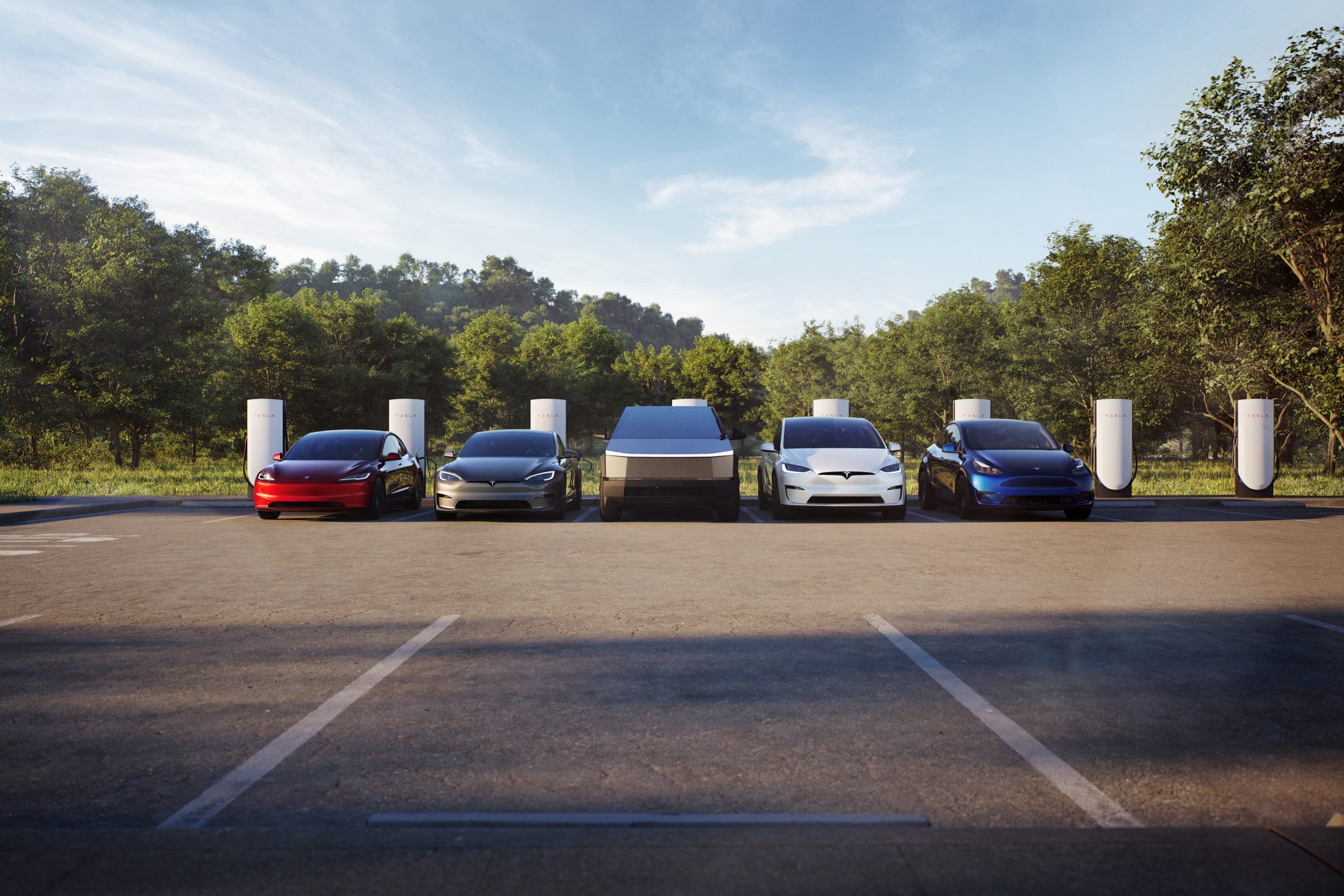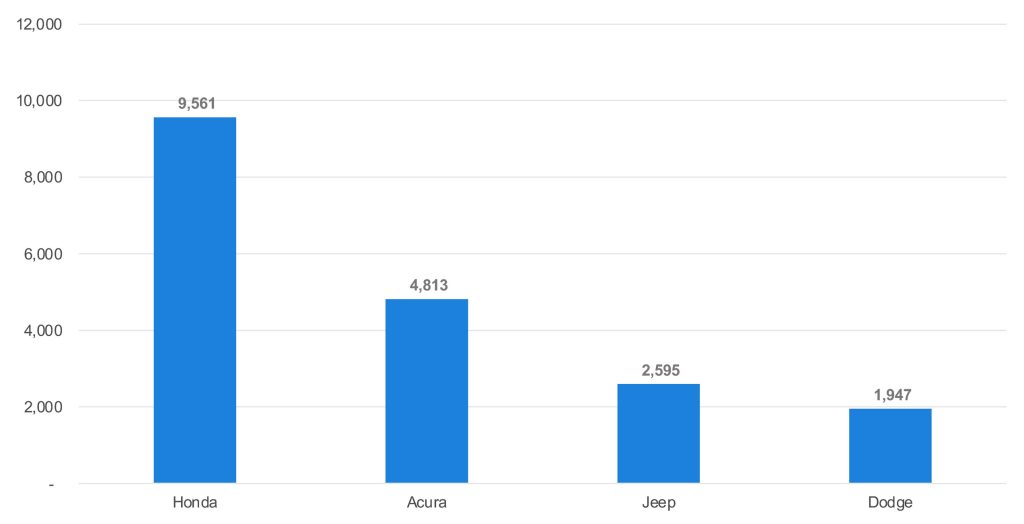News
These were the best-selling EV brands in the U.S. in Q1
Tesla remained the clear market leader in Q1, while Chevrolet and others saw substantial sales growth with the introduction of new models.

A recent report has revealed the latest estimates on electric vehicle (EV) sales for the first quarter of the year, with Tesla and Ford landing the top two spots, while GM’s brands saw the most sales growth.
On Thursday, Cox Automotive released data estimates for the U.S. EV market in Q1 2025, showing that Tesla remained the clear market leader among brands, while Ford, GM, BMW, and Hyundai made up the rest of the top five. The report estimated 296,227 EVs sold overall, marking an 11.4 percent increase year over year, and bringing new-vehicle EV sales to around 7.5 percent of the market.
Cox notes that this is still a steady increase from 7 percent of the market during Q1 last year, despite headwinds created by the Trump administration’s tariff war.
“The year certainly started strong, but the road ahead will be anything but smooth,” said Valdez Streaty, Cox Automotive analyst.
Tesla outsold the next top 10 brand names combined in Q1 with 128,100 units, though sales declined 8.6 percent year over year for the brand. Ford was the second-best-selling brand with 22,550 units sold, representing an 11.5 percent increase year over year.
Meanwhile, GM’s Chevrolet brand saw a 114.2 percent increase in sales from the first quarter of 2024 with 19,186, as led by the Chevy Equinox EV. The rest of the top 10 was made up, in order, by VW (9,564), Honda (9,561), Kia (8,656), Rivian (8,553), and Cadillac (7,972).
Brands such as Porsche, Toyota, and GMC joined the Chevy brand in seeing substantial sales growth, representing 249 percent, 196 percent, and 183 percent increases year over year, respectively.
It’s worth noting that multiple automakers own different brands, such as Chevrolet, GMC, and Cadillac being owned by GM, Audi being owned by VW, or Stellantis owning Jeep and Dodge, among other examples still.
EV Sales Volume Change by Brand: Q1 2025 versus Q1 2024

Credit: Cox Automotive
New Entries: EV Sales Volume in Q1 2025

Credit: Cox Automotive
READ MORE ON EV SALES: Tesla vs. competition: How many BEVs did OEMs sell in the U.S. in 2024?
Tesla doesn’t break out sales data by region, though the company recently reported delivering 336,681 units globally in the first quarter, representing a 13-percent drop from Q1 2024.
While it’s not a surprise that Tesla’s market share steadily declines as more competition enters the market, recent pressure on Elon Musk for his involvement with the Trump administration has, if nothing else, caused some automakers to try to poach Tesla owners with special trade-ins and other promotions.
Tesla has also been rolling out the refreshed Model Y, and the potential effects of the transition to it from the legacy model may play a role, though future quarters will show a better glimpse at the impact of the redesigned vehicle’s arrival.
At the time of writing, Cox Automotive has also not yet responded to Teslarati’s request for clarification on which brands are included in the “additional EV models” category. However, we expect these to include low-volume, luxury, and other niche EV brands, such as Lucid Motors. The publication also says the data overall excludes super exotics.
You can see EV sales ranked by brand below, check out the full data from Cox Automotive here, or read the publication’s press release on the report here.
Mass-market EV sellers in Q1 2025, ranked by brand
- Tesla: 128,100
- Ford: 22,500
- Chevrolet: 19,186
- BMW:13,538
- Hyundai: 12,843
- VW: 9,564
- Honda: 9,561
- Kia: 8,656
- Rivian: 8,553
- Cadillac: 7,972
- Nissan: 6,471
- Audi: 5,905
- Toyota: 5,610
- Acura: 4,813
- GMC: 4,728
- Porsche: 4,358
- Mercedes: 3,472
- Subaru: 3,131
- Volvo: 2,718
- Jeep: 2,595
- Dodge: 1,947
- Genesis: 1,496
- Lexus: 1,453
- Mini: 696
- Jaguar: 381
- Additional EV models*: 5,390
Total EV sales estimated by KBB in the U.S. in Q1 2025: 296,227
*The additional EV models category is likely made up of low-volume, luxury, and niche EV makers
Top 10 EV models sold in the U.S. in Q1 2025
- Tesla Model Y: 64,051
- Tesla Model 3: 52,520
- Ford Mustang Mach-E: 11,607
- Chevrolet Equinox EV: 10,329
- Honda Prologue: 9,561
- Hyundai Ioniq 5: 8,611
- VW ID.4: 7,663
- Ford F-150 Lightning: 7,187
- BMW i4: 7,125
- Tesla Cybertruck: 6,406
Here’s how many EVs were sold in the U.S. last year by model

Elon Musk
Elon Musk and Tesla AI Director share insights after empty driver seat Robotaxi rides
The executives’ unoccupied tests hint at the rapid progress of Tesla’s unsupervised Robotaxi efforts.

Tesla CEO Elon Musk and AI Director Ashok Elluswamy celebrated Christmas Eve by sharing personal experiences with Robotaxi vehicles that had no safety monitor or occupant in the driver’s seat. Musk described the system’s “perfect driving” around Austin, while Elluswamy posted video from the back seat, calling it “an amazing experience.”
The executives’ unoccupied tests hint at the rapid progress of Tesla’s unsupervised Robotaxi efforts.
Elon and Ashok’s firsthand Robotaxi insights
Prior to Musk and the Tesla AI Director’s posts, sightings of unmanned Teslas navigating public roads were widely shared on social media. One such vehicle was spotted in Austin, Texas, which Elon Musk acknowleged by stating that “Testing is underway with no occupants in the car.”
Based on his Christmas Eve post, Musk seemed to have tested an unmanned Tesla himself. “A Tesla with no safety monitor in the car and me sitting in the passenger seat took me all around Austin on Sunday with perfect driving,” Musk wrote in his post.
Elluswamy responded with a 2-minute video showing himself in the rear of an unmanned Tesla. The video featured the vehicle’s empty front seats, as well as its smooth handling through real-world traffic. He captioned his video with the words, “It’s an amazing experience!”
Towards Unsupervised operations
During an xAI Hackathon earlier this month, Elon Musk mentioned that Tesla owed be removing Safety Monitors from its Robotaxis in Austin in just three weeks. “Unsupervised is pretty much solved at this point. So there will be Tesla Robotaxis operating in Austin with no one in them. Not even anyone in the passenger seat in about three weeks,” he said. Musk echoed similar estimates at the 2025 Annual Shareholder Meeting and the Q3 2025 earnings call.
Considering the insights that were posted Musk and Elluswamy, it does appear that Tesla is working hard towards operating its Robotaxis with no safety monitors. This is quite impressive considering that the service was launched just earlier this year.
Elon Musk
Starlink passes 9 million active customers just weeks after hitting 8 million
The milestone highlights the accelerating growth of Starlink, which has now been adding over 20,000 new users per day.

SpaceX’s Starlink satellite internet service has continued its rapid global expansion, surpassing 9 million active customers just weeks after crossing the 8 million mark.
The milestone highlights the accelerating growth of Starlink, which has now been adding over 20,000 new users per day.
9 million customers
In a post on X, SpaceX stated that Starlink now serves over 9 million active users across 155 countries, territories, and markets. The company reached 8 million customers in early November, meaning it added roughly 1 million subscribers in under seven weeks, or about 21,275 new users on average per day.
“Starlink is connecting more than 9M active customers with high-speed internet across 155 countries, territories, and many other markets,” Starlink wrote in a post on its official X account. SpaceX President Gwynne Shotwell also celebrated the milestone on X. “A huge thank you to all of our customers and congrats to the Starlink team for such an incredible product,” she wrote.
That growth rate reflects both rising demand for broadband in underserved regions and Starlink’s expanding satellite constellation, which now includes more than 9,000 low-Earth-orbit satellites designed to deliver high-speed, low-latency internet worldwide.
Starlink’s momentum
Starlink’s momentum has been building up. SpaceX reported 4.6 million Starlink customers in December 2024, followed by 7 million by August 2025, and 8 million customers in November. Independent data also suggests Starlink usage is rising sharply, with Cloudflare reporting that global web traffic from Starlink users more than doubled in 2025, as noted in an Insider report.
Starlink’s momentum is increasingly tied to SpaceX’s broader financial outlook. Elon Musk has said the satellite network is “by far” the company’s largest revenue driver, and reports suggest SpaceX may be positioning itself for an initial public offering as soon as next year, with valuations estimated as high as $1.5 trillion. Musk has also suggested in the past that Starlink could have its own IPO in the future.
News
NVIDIA Director of Robotics: Tesla FSD v14 is the first AI to pass the “Physical Turing Test”
After testing FSD v14, Fan stated that his experience with FSD felt magical at first, but it soon started to feel like a routine.

NVIDIA Director of Robotics Jim Fan has praised Tesla’s Full Self-Driving (Supervised) v14 as the first AI to pass what he described as a “Physical Turing Test.”
After testing FSD v14, Fan stated that his experience with FSD felt magical at first, but it soon started to feel like a routine. And just like smartphones today, removing it now would “actively hurt.”
Jim Fan’s hands-on FSD v14 impressions
Fan, a leading researcher in embodied AI who is currently solving Physical AI at NVIDIA and spearheading the company’s Project GR00T initiative, noted that he actually was late to the Tesla game. He was, however, one of the first to try out FSD v14.
“I was very late to own a Tesla but among the earliest to try out FSD v14. It’s perhaps the first time I experience an AI that passes the Physical Turing Test: after a long day at work, you press a button, lay back, and couldn’t tell if a neural net or a human drove you home,” Fan wrote in a post on X.
Fan added: “Despite knowing exactly how robot learning works, I still find it magical watching the steering wheel turn by itself. First it feels surreal, next it becomes routine. Then, like the smartphone, taking it away actively hurts. This is how humanity gets rewired and glued to god-like technologies.”
The Physical Turing Test
The original Turing Test was conceived by Alan Turing in 1950, and it was aimed at determining if a machine could exhibit behavior that is equivalent to or indistinguishable from a human. By focusing on text-based conversations, the original Turing Test set a high bar for natural language processing and machine learning.
This test has been passed by today’s large language models. However, the capability to converse in a humanlike manner is a completely different challenge from performing real-world problem-solving or physical interactions. Thus, Fan introduced the Physical Turing Test, which challenges AI systems to demonstrate intelligence through physical actions.
Based on Fan’s comments, Tesla has demonstrated these intelligent physical actions with FSD v14. Elon Musk agreed with the NVIDIA executive, stating in a post on X that with FSD v14, “you can sense the sentience maturing.” Musk also praised Tesla AI, calling it the best “real-world AI” today.








